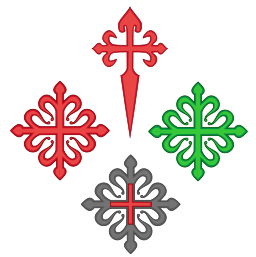

The small cross found on Spanish bayonets made in Germany is sometimes incorrectly referred to as a “Maltese Cross.” The Santiago Cross or Cruz Espada (Sword Cross) symbolizes the Medieval Spanish Military Orders, religious-military institutions that recaptured the Iberian Peninsula (present-day Spain and Portugal) from Moorish occupation during the 11th through 13th Centuries in what is known as the Reconquista.
The Orders of Santiago, Calatrava, Alcántara and Montesa were all represented by badges (pictured at right) derived from the Cross of St. James: a Greek cross with fleur-de-lis surmounted by a scallop shell at its ends, sometimes the lower limb is pointed in the shape of a sword. According to the Bible, James was one of the Twelve Apostles of Jesus; the first to be martyred. Saint James is the patron saint of Spain and James' emblem was the scallop shell.
Over time, these traditional orders largely became social, honorary institutions. They were banned when the monarchy was overthrown in 1931 and many of their members were murdered or executed during the Spanish Civil War. The four military orders represented by this symbol were officially reinstituted as civil associations in the 1980s. Many of the highest military and civil decorations bestowed by the Spanish Government today trace their origins and traditions to these historic Spanish Military Orders.



